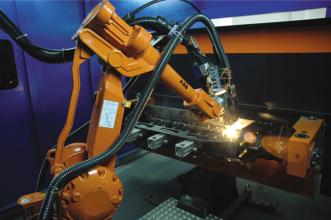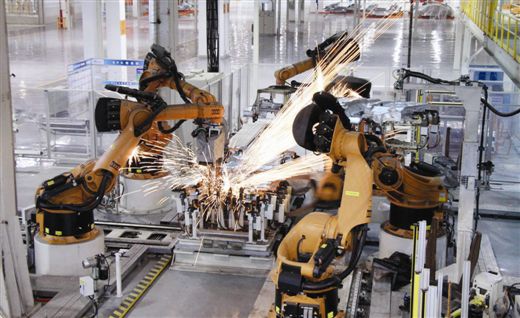As a new material of stainless steel material, its own has the characteristic such as corrosion resistance, formability, in the aerospace, automotive accessories, and other fields has been widely applied.And laser welding in the application of stainless steel occupies very important position, especially in the auto industry, body all adopt welding mode connection.However, influenced by many factors, stainless steel plate welding deformation problems, and control is difficult, is not conducive to the sustainable development in related field.Therefore, to strengthen the research of laser welding of stainless steel plate deformation is of great significance.
1 summary of laser welding
Laser welding is mainly refers to the use of laser melting and connecting the workpiece can be used as heat source of a welding method.In the process of laser welding, laser irradiation to the surface of welding material, and its effect, and part is reflected, the rest is absorbed, enter the material, the welding.In short, the process of laser welding is used by the optical system of high power laser beam after focusing, exposure to the surface of welding material, and then make full use of the materials of light energy absorption for heating treatment yuan finally after cooling form a melt welding process of welded joint.Typically, deep penetration laser welding is mainly divided into heat conduction welding and two categories.
2 welding deformation of harm and the main factors influencing the welding deformation
The main factors influencing the welding deformation of welding current, pulse width and frequency.The welding current is added, the weld width also will increase, gradually appear the phenomenon such as splash, lead to deformation of weld surface oxidation, accompanied by rough feeling;Pulse width increases, increase strength of welded joint, when the pulse width to a certain extent, the material on the surface of the heat transfer energy consumption also will increase, make the liquid evaporation from the molten pool spatter, lead to solder joint sectional area is smaller, affect the joint strength;Welding frequency to the influence of the stainless steel plate welding deformation is closely related to the thickness of the steel plate, etc, such as for 0.5 mm stainless steel plate, when the frequency reaches 2 hz, weld overlap rate is higher;And when the frequency reaches 5 hz, weld burning is serious, with wider range of heat affected zone, deformation.Thus, it is imperative to strengthen the effective control of welding deformation.
3 some effective measures to avoid laser welding deformation
In order to reduce the laser welding deformation problems, and improve the welding quality of stainless steel plate, can from the welding process parameters were optimized, specific operation method is as follows:
3.1 actively introducing orthogonal experiment method
Orthogonal experimental method is mainly refers to a schedule by orthogonal table analysis and multi-factor test method of mathematical statistics.Able to take advantage of less test to obtain effective results, and deduce the best scheme., the thorough analysis at the same time, also can to obtain more information, provide the basis for the specific work.Generally choose the welding current, pulse width, and mainly studies as the object, such as the laser frequency will welding deformation as the indexes, should be controlled to the minimum, and adhere to the principle of reasonable, control factor levels in the appropriate range.As for the thickness of 0.5 mm stainless steel plate, current can be controlled between 80 ~ 96 I/A.Frequency of 2 ~ 5 f/Hz, etc.
3.2 the choice of orthogonal table
Normally, test factors level number should be consistent with the horizontal orthogonal table, number of factors should be less than the number of columns in the orthogonal table, the reasonable design of orthogonal table can provide support and assistance for subsequent research.
3.3 poor test results analysis
Through the thickness of 0.5 mm stainless steel plate test result, poor each column are not equal, and prove that each factor has particularity, different level is different, the effects of impact on laser welding deformation of current, pulse width and frequency, considering various factors, the laser welding process parameters should be best current control 85 a, pulse width of 7 ms, frequency of 3 hz, the welding process parameters are controlled in three numerical can guarantee minimum thickness of 0.5 mm stainless steel plate welding deformation.
For stainless steel plate thickness of 0.8 mm stainless steel plate, in the weld deformation of tensile strength on the basis of ensuring the most hours, should be current, pulse width and frequency control respectively in 124 a, 8 parameters, such as ms, 4 hz.And the thickness of 1 mm stainless steel plate 160 a, 11 ms respectively, 5 hz.In laser welding process, welding personnel to control the parameters within a reasonable range, can not only improve the welding quality and efficiency, and to avoid the plate deformation, meet the production requirements.Along with the rapid development of science and technology, technology is developing to control deformation, such as the finite element simulation application in the welding deformation control, by using welding temperature and stress to avoid welding deformation problems, improve stress balance of stainless steel plate, in avoiding the steel plate welding deformation at the same time, also can improve the quality of welding, so as to promote the healthy development of the related areas.
4 conclusion
According to the mentioned above, the laser welding process as a kind of effective welding technology, plays a positive role in improving welding quality.But, under the influence of factors such as the laser current, stainless steel plate laser welding problems such as deformation.The welding workers can adopt orthogonal experiment method for obtaining the best technological parameters, different thickness steel plate combined with the parameters of welding work, continuously improve the quality of welding, to avoid maximum deformation of steel plate.


